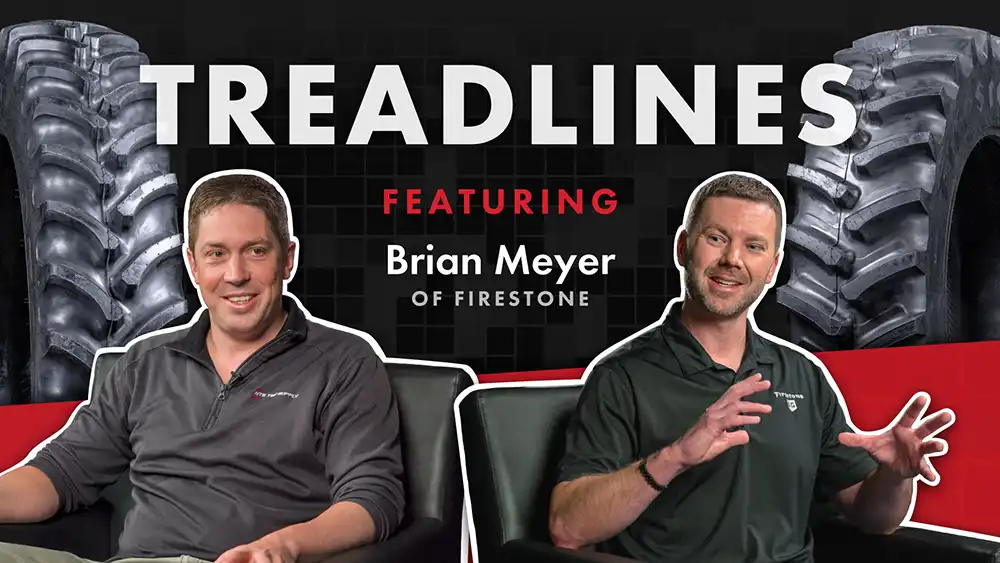Fall harvest and tillage are right around the corner, and with this busy season comes some of the heaviest pulling of the year for your tracked machine(s). It’s vital that you remember to check the health of your tracks and undercarriage before you head into harvest. A misaligned track, a worn-out midroller, or cracked drive lugs can bring harvest to a halt when you need to be moving at full speed. We created the following checklist to help you roll smoothly through harvest on your tracked machine.

4-Point Track Inspection Checklist
1. Tread bar: Essential to Keep Your Harvest on Track
Damage can range from cosmetic to catastrophic. If any part of the cable package is exposed anywhere on the track itself, you’ll need to replace it. Also look at the wear pattern. Long roading down paved roads is a major cause of excessive and uneven tread wear. If you find yourself with long distances to travel on tar (or concrete), you may want to upgrade to a high-roading track model.
You’ll also want to look at the underside of the track. If steel cables are exposed due to wear between the track and the rollers, you’ll need to replace the track. It’s important to clean your tracks at the start of each work day, as debris such as stones can quickly cause damage as they’re pressed between the rollers and track surface.
2. Undercarriage Components: Find Problems Early to Prevent a Mid-Season Failure
Spotting wear on the rubberized surface of your midrollers, idlers, or drive wheels can avoid a time-consuming breakdown during heavy pulling. Heat is the #1 enemy of tracks, and the midrollers take the brunt of heat buildup during extreme operations. As the temperature climbs, they lose cut and tear resistance. If a cut has started on the edge of a midroller, you’ll have to keep a close eye on it. If there are flat spots or a significant portion of the coating is missing on your midrollers, you’ll have to replace them immediately or risk damage to the entire track system. If you notice your midrollers beginning to round or dome, with more rubber across the middle of the roller and less at the edges, don’t worry—this is a normal wear progression.
Another solution to combating midroller failure is to invest in polyurethane midrollers. At NTS Tire Supply, we offer AgriTraxx® Midrollers by Superior Tire and Rubber Corporation to help ensure more uptime under demanding field conditions. These rollers slide easier against the rubber track and avoid the destructive heating/cooling cycles that ruin standard rubber midrollers. Superior also offers a no bond failure guarantee on its midrollers. Contact NTS Tire Supply to learn if polyurethane rollers can give you the edge in warding off track failure this fall.
3. Guide/Drive Lugs: Inspect Closely to Ensure Maximum Uptime
Look for chunking, chipping, and cuts to the lug surface. You’ll also have to look for cracks at the base of the lugs as well. These can start small and eventually widen and cause the lug to separate from the track. Always store tracks indoors, if possible, to avoid damage from sunlight, which can start these small tracks in motion. Excessive high-speed roading will also place a lot of stress on guide lugs. If you’re a heavy roader, it may be time to look at a high-roading track model to avoid early replacement.
4. Alignment: Save Money by Extending Track Life
Faulty track alignment can cause all of the problems mentioned above—damage not only to the track itself but to the undercarriage components as well. The most efficient way to check your track alignment is with an infrared thermometer. Run for 5 minutes or so down the road (during dry conditions) then stop and check the temperature of a couple guide lugs on both the inside and outside edges. If there’s a temperature difference of around 20º or more, you have an alignment problem. For the best results you want to check only one track at a time using this method. Why? As you’re checking one track the other one (or three) are cooling and you may not get accurate readings.
Once again, you’ll have to dig out your owner’s manual to find the process for aligning your specific tracks. You may want to repeat an alignment test every 100 hours or so during operation, because faulty alignment can quickly cook track components and lead to an expensive and time-consuming breakdown when you least want one.
If the need for new tracks, idlers, or midrollers crops up during your pre-harvest checks, be sure to call or drop NTS Tire Supply a line. A track expert will ask you about your operation and find the best balance of price and performance for your needs. Be sure to take time this summer to review the track health on all your equipment and hopefully a track failure won’t slow your harvest down.

.png)
.jpg)



















